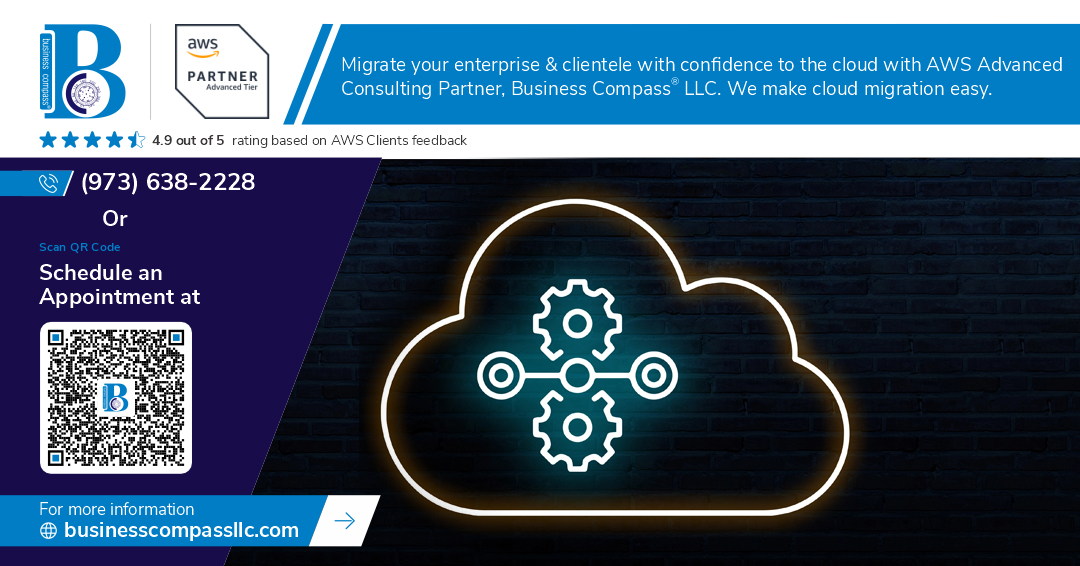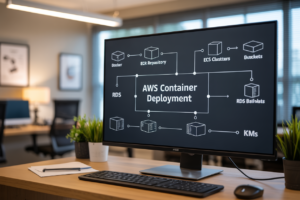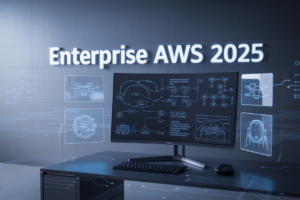🚀 Are you ready to take your AWS infrastructure to new heights? In today’s digital landscape, high availability is no longer a luxury—it’s a necessity. But with the ever-expanding array of AWS compute services, finding the right scaling strategy can feel like navigating a complex maze.
Fear not! Whether you’re wrestling with EC2 instances, dabbling in serverless with Lambda, or diving into the world of containers with Fargate, ECS, or EKS, we’ve got you covered. In this comprehensive guide, we’ll unravel the mysteries of scaling compute resources for maximum availability. From understanding the nuances of each service to implementing multi-region strategies, we’ll equip you with the knowledge to build robust, scalable architectures that can weather any storm.
Buckle up as we embark on a journey through AWS’s compute landscape. We’ll explore scaling techniques for EC2, serverless solutions with Lambda, container orchestration with Fargate and ECS, and the power of Kubernetes with EKS. By the end of this post, you’ll have a toolbox full of strategies to ensure your applications are always available, performant, and ready to handle whatever the digital world throws their way. Let’s dive in and unlock the potential of AWS compute scaling! 💪🔍
Understanding AWS Compute Services
A. EC2: Flexible virtual servers
Amazon Elastic Compute Cloud (EC2) offers scalable computing capacity in the AWS cloud. It provides a wide range of instance types optimized for different use cases, allowing you to choose the most suitable configuration for your applications.
Key features of EC2:
- Diverse instance types (compute, memory, storage optimized)
- Multiple pricing options (On-Demand, Reserved, Spot)
- Integration with other AWS services
- Auto Scaling capabilities
| Instance Family | Use Case | Example Types |
|---|---|---|
| General Purpose | Balanced workloads | t3, m5 |
| Compute Optimized | High-performance computing | c5, c6g |
| Memory Optimized | Large-scale, in-memory processing | r5, x1 |
| Storage Optimized | High I/O operations | i3, d2 |
B. Lambda: Serverless functions
AWS Lambda enables you to run code without provisioning or managing servers. It automatically scales your application by running code in response to events or HTTP requests.
Benefits of Lambda:
- Pay-per-use pricing model
- Automatic scaling
- Event-driven architecture support
- Integration with various AWS services
C. Fargate: Containerized applications
AWS Fargate is a serverless compute engine for containers that works with both Amazon ECS and EKS. It allows you to focus on building applications without managing the underlying infrastructure.
D. ECS: Container orchestration
Amazon Elastic Container Service (ECS) is a fully managed container orchestration service that supports Docker containers. It allows you to easily run, stop, and manage containers on a cluster.
E. EKS: Managed Kubernetes
Amazon Elastic Kubernetes Service (EKS) is a managed Kubernetes service that makes it easy to deploy, manage, and scale containerized applications using Kubernetes. It provides a fully managed control plane and automated updates for Kubernetes.
Now that we’ve covered the core AWS compute services, let’s explore scaling strategies for high availability in the next section.
Scaling Strategies for High Availability
Vertical scaling: Increasing instance size
Vertical scaling, also known as “scaling up,” involves increasing the resources of individual instances to handle higher workloads. This method is straightforward but has limitations:
| Pros | Cons |
|---|---|
| Simple to implement | Limited by hardware constraints |
| No application changes required | Potential downtime during upgrades |
| Suitable for databases | Cost-ineffective for large-scale applications |
Horizontal scaling: Adding more instances
Horizontal scaling, or “scaling out,” involves adding more instances to distribute the workload. This approach offers greater flexibility and scalability:
- Improved fault tolerance
- Better cost efficiency for large-scale applications
- Easier to achieve high availability
Auto-scaling groups: Automated resource management
Auto Scaling Groups (ASGs) in AWS dynamically adjust the number of instances based on predefined conditions:
- Set minimum and maximum instance counts
- Define scaling policies based on metrics (e.g., CPU utilization)
- Automatically replace unhealthy instances
Load balancing: Distributing traffic effectively
Load balancers play a crucial role in high availability by distributing incoming traffic across multiple instances:
- Elastic Load Balancer (ELB) options:
- Application Load Balancer (ALB)
- Network Load Balancer (NLB)
- Classic Load Balancer (CLB)
Load balancers work in tandem with Auto Scaling Groups to ensure optimal resource utilization and high availability.
Now that we’ve covered the fundamental scaling strategies for high availability, let’s explore how these concepts apply specifically to EC2 instances.
EC2 Scaling Techniques
Instance types and families
When scaling EC2 instances for high availability, selecting the right instance type is crucial. AWS offers a diverse range of EC2 instance families, each optimized for specific use cases:
| Instance Family | Optimized For | Use Cases |
|---|---|---|
| General Purpose | Balanced performance | Web servers, small databases |
| Compute Optimized | High CPU performance | Batch processing, scientific modeling |
| Memory Optimized | Fast memory performance | In-memory databases, real-time analytics |
| Storage Optimized | High I/O performance | Data warehousing, distributed file systems |
Choosing the appropriate instance type ensures optimal performance and cost-efficiency for your workload.
Elastic Load Balancing (ELB)
ELB is a critical component in EC2 scaling, distributing incoming traffic across multiple instances. AWS offers three types of load balancers:
- Application Load Balancer (ALB)
- Network Load Balancer (NLB)
- Classic Load Balancer (CLB)
ALB is ideal for HTTP/HTTPS traffic, while NLB handles TCP/UDP traffic at ultra-low latency. CLB, though still supported, is considered legacy.
EC2 Auto Scaling
EC2 Auto Scaling automatically adjusts the number of instances based on defined conditions. Key features include:
- Launch Templates: Define instance configurations
- Scaling Policies: Set rules for scaling in/out
- Scheduled Actions: Scale based on predictable load patterns
Auto Scaling ensures your application maintains performance during traffic spikes while optimizing costs during low-demand periods.
Now that we’ve covered EC2 scaling techniques, let’s explore how serverless architectures can be scaled using AWS Lambda.
Serverless Scaling with Lambda
Concurrent executions
AWS Lambda automatically scales your functions by running multiple instances concurrently. This allows your serverless applications to handle sudden spikes in traffic without manual intervention. The default concurrent execution limit is 1,000 per AWS account per region, but this can be increased upon request.
| Concurrent Execution Limit | Description |
|---|---|
| Default | 1,000 per account per region |
| Maximum | Can be increased to tens of thousands |
| Per Function | Can be set individually |
- Benefits of concurrent executions:
- Automatic scaling
- Cost-effective (pay only for what you use)
- No infrastructure management
Provisioned concurrency
Provisioned concurrency is a feature that keeps functions initialized and ready to respond to requests with consistent start-up latency. This is particularly useful for applications that are sensitive to cold starts.
- Key aspects of provisioned concurrency:
- Pre-warms function instances
- Reduces latency for time-sensitive applications
- Can be configured on specific versions or aliases
Function versioning and aliases
Lambda function versioning allows you to manage different iterations of your function code. Aliases act as pointers to specific versions, enabling easier management and deployment strategies.
- Versioning benefits:
- Maintain multiple function variations
- Rollback capability
- A/B testing
Aliases provide a way to route traffic between different versions, facilitating gradual rollouts and blue-green deployments. This approach enhances the overall scalability and reliability of your serverless applications.
Now that we’ve covered serverless scaling with Lambda, let’s explore how container-based services like Fargate and ECS handle scaling for high availability.
Container Scaling with Fargate and ECS
Task definitions and service scaling
When scaling containers with AWS Fargate and ECS, task definitions and service scaling play crucial roles. Task definitions specify the container requirements, while service scaling determines how many tasks run simultaneously.
Key components of task definitions:
- Container image
- CPU and memory allocation
- Port mappings
- Environment variables
- Networking mode
Service scaling in ECS allows you to automatically adjust the number of tasks based on various metrics:
| Metric | Description |
|---|---|
| CPU Utilization | Scale based on average CPU usage |
| Memory Utilization | Scale based on average memory usage |
| ALB Request Count Per Target | Scale based on incoming requests |
To implement effective service scaling:
- Set appropriate minimum and maximum task counts
- Configure target tracking or step scaling policies
- Use appropriate cooldown periods to prevent rapid scaling
Cluster auto-scaling
Cluster auto-scaling ensures that your ECS cluster has sufficient resources to run all desired tasks. It works by automatically adjusting the number of EC2 instances in your cluster based on resource requirements.
Key benefits of cluster auto-scaling:
- Optimizes resource utilization
- Reduces costs by scaling down during low demand
- Ensures capacity for sudden traffic spikes
To implement cluster auto-scaling effectively:
- Enable managed scaling for your ECS cluster
- Configure capacity providers to manage EC2 Auto Scaling groups
- Set appropriate scaling thresholds and cooldown periods
Service discovery and load balancing
Service discovery simplifies container communication within your ECS cluster, while load balancing distributes traffic across multiple containers for improved availability and performance.
Kubernetes Scaling with EKS
Pod autoscaling (HPA)
Kubernetes Horizontal Pod Autoscaler (HPA) is a powerful feature that automatically adjusts the number of pod replicas based on observed CPU utilization or custom metrics. In Amazon EKS, HPA can be easily configured to ensure your applications scale efficiently.
To implement HPA:
- Define resource requests and limits for your pods
- Create an HPA resource with desired metrics and thresholds
- Monitor and fine-tune as needed
Here’s an example HPA configuration:
apiVersion: autoscaling/v2beta1
kind: HorizontalPodAutoscaler
metadata:
name: my-app-hpa
spec:
scaleTargetRef:
apiVersion: apps/v1
kind: Deployment
name: my-app
minReplicas: 2
maxReplicas: 10
metrics:
- type: Resource
resource:
name: cpu
targetAverageUtilization: 50
Cluster autoscaler
The Cluster Autoscaler automatically adjusts the number of nodes in your EKS cluster based on resource demands. This ensures optimal resource utilization and cost-efficiency.
Key benefits of Cluster Autoscaler:
- Automatically scales worker nodes
- Prevents resource bottlenecks
- Optimizes cluster costs
To enable Cluster Autoscaler in EKS:
- Create an IAM policy for the autoscaler
- Associate the policy with the EKS node group
- Deploy the Cluster Autoscaler as a Deployment in your cluster
Node groups and managed node groups
EKS offers two types of node groups:
| Type | Description | Benefits |
|---|---|---|
| Self-managed | You manage the EC2 instances | Full control over node configuration |
| Managed | AWS manages the EC2 instances | Simplified operations and automatic updates |
Managed node groups provide several advantages:
- Automatic updates and patching
- Graceful node termination
- Easy scaling and management through EKS console
When configuring node groups, consider:
- Instance types based on workload requirements
- Minimum and maximum node counts
- Labels and taints for workload placement
By leveraging these EKS scaling features, you can build a highly available and efficient Kubernetes infrastructure on AWS.
Multi-Region and Multi-AZ Strategies
Global load balancing
Global load balancing is a crucial component of multi-region and multi-AZ strategies for achieving high availability in AWS. It allows you to distribute traffic across multiple regions, ensuring optimal performance and fault tolerance.
Key benefits of global load balancing:
- Improved latency
- Enhanced fault tolerance
- Disaster recovery support
- Geographic-based routing
AWS offers various services for implementing global load balancing:
| Service | Description | Use Case |
|---|---|---|
| Route 53 | DNS-based routing | Simple, cost-effective global routing |
| Global Accelerator | IP address-based routing | Performance-sensitive applications |
| CloudFront | Content delivery network | Static and dynamic content distribution |
Cross-region replication
Cross-region replication is essential for maintaining data consistency and availability across multiple AWS regions. This strategy involves:
- Replicating data stores (e.g., RDS, DynamoDB)
- Synchronizing application states
- Ensuring consistent configurations across regions
Benefits of cross-region replication:
- Data redundancy
- Improved disaster recovery
- Reduced latency for global users
- Compliance with data sovereignty requirements
Disaster recovery planning
A comprehensive disaster recovery plan is crucial for maintaining high availability in multi-region and multi-AZ deployments. Key components include:
- Regular backups and testing
- Automated failover mechanisms
- Clear communication protocols
- Defined recovery time objectives (RTO) and recovery point objectives (RPO)
Implementing these strategies ensures your AWS compute resources remain highly available and resilient to failures. Next, we’ll explore how to monitor and optimize scalability to maintain peak performance across your multi-region infrastructure.
Monitoring and Optimizing Scalability
CloudWatch metrics and alarms
CloudWatch is essential for monitoring and optimizing scalability in AWS. It provides valuable insights into your application’s performance and resource utilization. Here are key metrics to monitor:
- CPU Utilization
- Memory Usage
- Network In/Out
- Request Count
- Error Rates
Setting up CloudWatch alarms allows you to automate responses to performance issues:
| Alarm Type | Threshold | Action |
|---|---|---|
| High CPU | > 70% | Scale out |
| Low CPU | < 30% | Scale in |
| High Error Rate | > 1% | Notify team |
| Response Time | > 2s | Investigate |
X-Ray for distributed tracing
X-Ray provides end-to-end tracing of requests as they traverse your distributed systems. It helps identify bottlenecks and optimize performance:
- Trace request flows across microservices
- Analyze latency between components
- Identify errors and exceptions
- Visualize service dependencies
Cost optimization techniques
To optimize costs while maintaining high availability:
- Use spot instances for non-critical workloads
- Implement auto-scaling to match demand
- Leverage reserved instances for predictable workloads
- Utilize AWS Savings Plans for long-term commitments
- Monitor and rightsize resources regularly
Next, we’ll explore multi-region and multi-AZ strategies to further enhance your high availability architecture.
Effectively scaling AWS compute services is crucial for maintaining high availability and optimal performance in modern cloud architectures. By leveraging EC2 Auto Scaling, Lambda’s automatic scaling, Fargate’s serverless containers, ECS’s cluster management, and EKS’s Kubernetes orchestration, organizations can build resilient and scalable applications that adapt to varying workloads. Additionally, implementing multi-region and multi-AZ strategies further enhances reliability and reduces the risk of downtime.
To ensure successful scaling, it’s essential to continuously monitor and optimize your infrastructure. Utilize AWS CloudWatch and other monitoring tools to gain insights into resource utilization and application performance. Regularly review and adjust your scaling policies, instance types, and container configurations to strike the right balance between cost-efficiency and performance. By mastering these scaling techniques across various AWS compute services, you’ll be well-equipped to build and maintain highly available, scalable applications that meet the demands of your users and business.




















